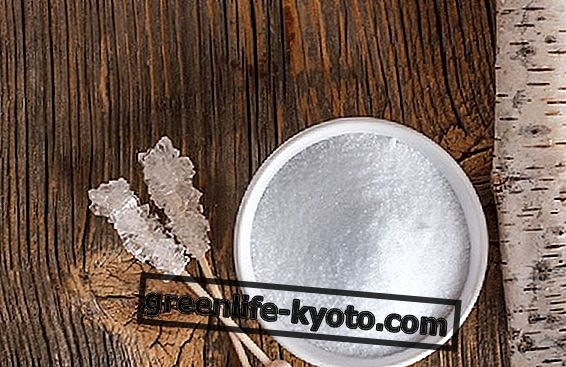The enula campana ( Inula helenium ) is a plant of the Asteraceae family (Compositae). Known for its mucolytic and diuretic properties, it is useful against catarrh, gout and rheumatism. Let's find out better.

Properties of the enula bell
The root of the enula (or elenio) contains 1 - 3% of essential oil (composed of sesquiterpene lactones, alantolactones and sesquiterpene hydrocarbons), sterols (beta-sitosterol, stigmasterol), mucilage, pectins, ascorbic acid and is one of the most notable inulin (44%), very important in medicine.
For internal use, the presence of essential oil gives the enupeptic action indicated for difficult digestion and lack of appetite; but above all the plant is renowned for its antiseptic, fluidifying and expectorant properties of phlegm, useful for the treatment of respiratory tract disorders, in the presence of coughs and cooling bronchitis, acute and chronic, asthma and emphysema.
The alantolactone mixture is called elenina or elenio camphor, and besides having anti-inflammatory and antiseptic properties, it carries out antifungal, anthelmintic and diuretic activity, helping the elimination of urea and chlorides, for this reason the use of the enula is also indicated against gout and some rheumatic forms.
For external use, decoctions and ointments based on enula are remedies for the treatment of itching following eczema, dermatosis, dermatitis, various cold sores and rashes in general.
Method of use
INTERNAL USE
INFUSION: 1 tablespoon of Enula root, 1 cup of water
Pour the plant into the boiling water and turn off the heat. Cover and leave to infuse for 10 min. Filter the infusion and drink three times a day, to calm the cough or eliminate uric acids
- Mother tincture of Enula campana : 30 drops three times a day away from meals
EXTERNAL USE
DECOCK: 10-30 grams of root in 500ml of water
Pour the chopped root into cold water, light the fire and bring to a boil. Boil a few minutes and turn off the heat. Cover and leave to infuse for 10 min. Once cooled, apply to calm and soothe itching and skin disorders
Contraindications of the enula bell
Enula can produce side effects such as allergic dermatitis, itching, mucosal irritation, vomiting, diarrhea, cramps. Other possible reactions may be due to established hypersensitivity to one or more components contained in the root.
The use of the Enula is not recommended during pregnancy and lactation . Avoid using Enula-based products during diuretic therapy to avoid interaction and side effects.
Description of the plant
Perennial herbaceous plant with large branched fleshy rhizome and with a very robust stem 100-200 cm tall. hairy, branched and corymb. The leaves are large; oblong, dentate, scabre superiorly and tomentose on the inferior page, the inferior picciolate and the sessile superior ones.
The flowers have golden-yellow heads. The fruits are glabrous achen, devoid of pappus.
The habitat of the enula bell
Native to central Asia, in Europe it is widespread especially in the southern areas where it was cultivated in the past for medicinal purposes and then it spread spontaneously in the Mediterranean basin.
In Italy it is present in the north, in the center and partly in southern Italy. It prefers the ruderal places and damp woodlands, coppices and ditches; but also the hygrophilous meadows and pastures.
Background
The name of the species helenium apparently derives from the Greek name Elena, which according to legend held the plant in hand when it left for Troy. The currently accepted scientific binomial (Inula helenium) was proposed by Carl von Linné in the publication Species Plantarum of 1753
According to Pliny: " It is said that elenio is born from Elena's tears and elenio is attributed cosmetic virtues: it maintains perfect, nourishing the female skin, both of the face and of the body. They also say that its use gives women beauty and a sensual charm ... "Given that the plant was somehow connected to the vicissitudes of Helen of Troy, the great Roman historian and naturalist thought of attributing cosmetic properties to the plant, even if in reality, it has nothing to do with with feminine beauty.
However, the enula is cited as an effective remedy in all the authors of Antiquity (from Dioscorides to Albertus Magnus) and in every Pharmacopoeia for its calming properties of expectorant and diuretic coughs.
Used since ancient times for the production of liqueurs, famous is the wine of Enula, used as an aperitif, which is obtained by adding a percentage of dried root to the wine . In Alzazia it is still produced today the reps, a drink that is prepared by macerating the root in the must . In fact, once the root of this plant was used by doctors as a stomach (it facilitates the digestive function), vermifuge (eliminates intestinal worms), tonic (strengthens the body in general), diuretic (facilitates the release of urine) and resolution in general.
It was also used both for dyeing cotton or blue linen clothes, and as a mordant in dyes with the addition of blackberries.
Today for the large flower variety it is also used in gardens to create ample patches of color.
At the beginning of the 20th century it was isolated from the enzyme root phytocomplex, inulin, a polysaccharide, with the known rebalancing properties of the bacterial flora, because it is able to increase the density of bifidobacteria and reduce that of harmful bacteria.
In collaboration with Erboristeria del Pigneto













